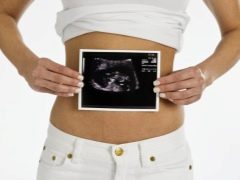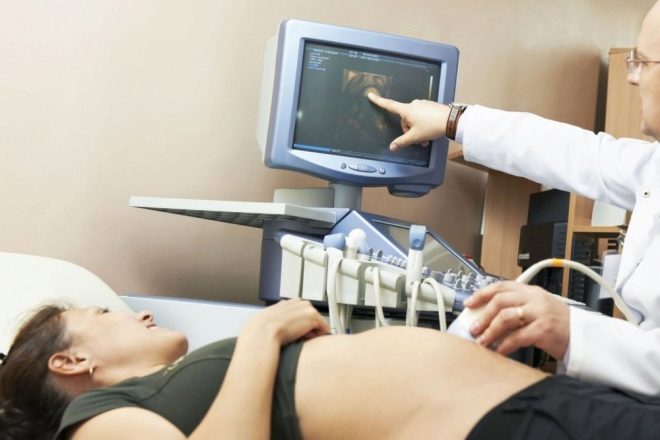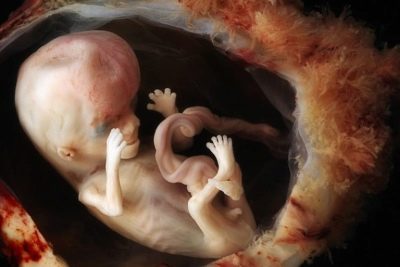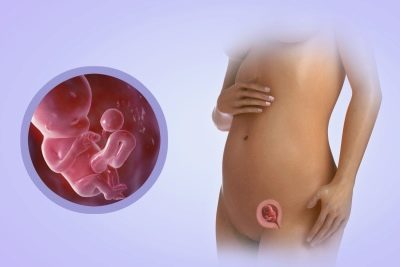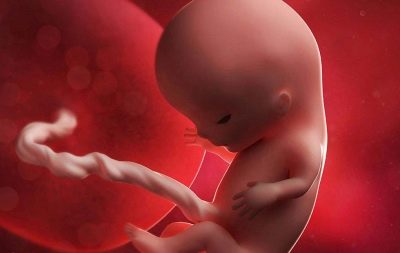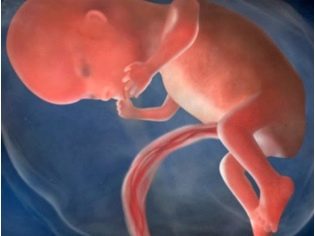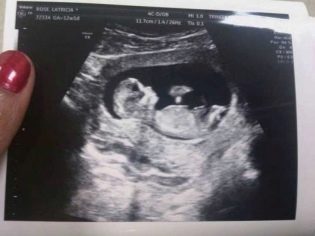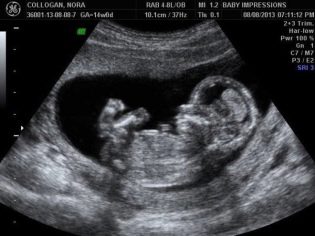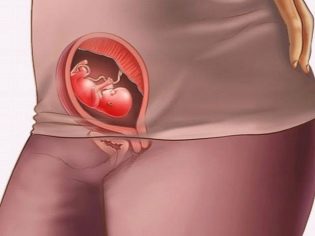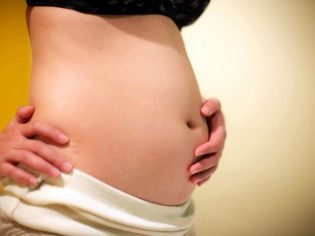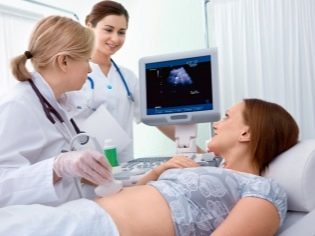Third month of pregnancy
The third month of pregnancy for many women is the most painful. Toxicosis and fear for the baby (the most dangerous period of intrauterine development is underway!) Can greatly complicate the woman’s life and well-being. But on the other hand, the third month completes the first trimester and after it comes a significant relief. This period is saturated with surveys, analyzes, the woman is sent to the first prenatal screening.
general information
The third month includes 9.10, 11, 12, and half 13 obstetric weeks. The term should begin to count from the first day of the last to conceive of menstruation.Since the day of conception itself cannot be established in most cases. The embryonic period (from conception) is, on average, two weeks less than obstetric, because the woman is not even pregnant for the first two weeks, only on the 14th day she ovulates and conception becomes possible.
The third month is not without reason considered to be one of the most difficult - most expectant mothers feel much worse, and there is no way to rest before maternity leave. At the end of the third month, the most favorable time comes to inform parents, relatives and older children, if they are in the family, about the upcoming replenishment.
Baby development
The third month of pregnancy completes the period of embryogenesis. Your baby will begin to be called no longer an embryo, but a fetus. So it will be up to the birth. There are no signs and symptoms of pregnancy, the delay to the beginning of the third month lasts for 5 weeks already, and during this time many women managed not only to do the test, but also to visit the doctor, register in the consultation and do the first ultrasound to make sure that the baby develops normally.
The kid has come a long way - from a single cell-zygote with a unique genetic set, he has become a full-fledged multicellular organism, which has completed the formation of all internal organs. In the third month, almost all organs and systems will appear and begin to work with him.
Heart crumbs already knocking confidently and rhythmically, it is perfectly audible during the passage of ultrasound diagnostics. All organs are laid and not only at the cellular level. Many organs have already begun to function.
Week 9
The nervous system is actively formed. Baby learned to move the handles and at the current time she masters a new skill - she learns to open her mouth in a reflex way. The crumb looks rather strange: a huge head compared to the body, eyes wide apart on the right and left of the face, holes for the ears, fins for fingers instead of fingers, short, barely marked legs, an embryonic tail that is already beginning to shrink. Soon there will be nothing at all - the tailbone.
This week, the need for calcium is high, as the foundation of milk teeth is being laid.. The brain of the child acquires an important appendage - the pituitary gland. The formation of the main nerve bundles begins. By the end of week 9, the baby begins to clench her hands into fists.
The liver produces immune cells, lymphocytes, are involved in the activity of the kidney and thyroid. At the end of the week, the functioning of the young placenta starts. From now on, the child is better protected.Since the “children's place” works not only the breadwinner and the oxygen supplier, but also a reliable barrier that will be able to hold back some harmful substances from maternal blood and prevent them from getting into the body of the crumbs.
The baby weighs already almost five grams, it is already five centimeters tall.
10 week
Baby has ceased to be an embryo. Fetal or fetal period started. He is now - a fetus in the womb, and all his internal organs have formed and look exactly the same as in adults, naturally, adjusted for size. At this time, the tail disappears. The baby has grown to ten grams and has grown to almost 6 centimeters.
Now the most intense pace will be the formation of the nervous system. The brain of the crumb is already two-hemispheric, but it still does not know how to direct the organs and movements of the limbs. - there is no necessary number of neural connections. They are beginning to form just now, and after a few days, the baby tries to pull her hands to her face.
Baby begins to drink amniotic fluid. They are derived through the kidneys - a crumb pisses in the same environment. It should not worry - the composition of amniotic fluid self-cleaning every 3-4 hours.
In the guise of a child, more human features appeared - he now has lips, a small nose, and auricles begin to form. The neck stands out and the child gets the opportunity to roll his head. At the current time, the need for calcium becomes higher as it starts the process of bone rejection. - they were soft, cartilaginous, now they have to become hard.
From now on, the baby will become more legible - taste buds are formed on the tongue and soon the crumb will acquire the ability to distinguish different tastes of amniotic fluid (their taste depends on what the woman eats).
11 week
A certain interaction begins to form between the internal organs - all parts of the child’s body learn to work “as a team”. And the baby starts to gain weight. Now the crumb has grown to 15 grams and has grown to almost 8 centimeters. He swims in the amniotic fluid, but mother can not yet feel his touch from the inside.
Baby learned to grab the umbilical cord handles. From this point on, he will have something to occupy for a short time, because most of the day he is in a state close to sleep.
The head begins to shrink, and soon the child will look more proportionate. The eyes have almost moved to the front of the head, the formation of the structures of the organs of vision begins.
At this time, the baby gains the skill, which will then give him the opportunity to walk - he pushes his feet from any obstacles he encounters in free swimming, for example, from the walls of the uterus.
12 week
At this time, the mother can look at her baby during the prenatal screening, which includes ultrasound diagnostics. The child has grown to 11 centimeters and now weighs almost 20 grams.
The facial structures continue to take shape. The eyes have taken their place on the face, the small ears acquire bumps, there are eyelids and a nose grows - its size can even be measured by ultrasound. Thanks to the spout, the face stops looking flat.
Baby has learned to suck - this reflex is important for its survival after birth. And some children can already quite suck their own fist or finger (fingers, by the way, are also separated from the "flipper").
Occasionally, the intestines begin to spontaneously contract. The girls' sex bump stops in the clitoris and labia, and the boys bump becomes a small penis. An experienced ultrasound specialist can already look at the floor of the crumbs, but without guarantees - the organs are still very small.
Appears facial expressions - the baby begins to fold the lips into a tube. And he knows how to make a gloomy expression on his face.
13 week
Growing baby weight. Now he has reached 30 grams with a growth of 12 centimeters.. The baby is very thin, wrinkled, scarlet or purple. Through the thin skin all available blood vessels are visible.The fetus does not have a stock of subcutaneous fat, due to which the skin becomes pink. Build up this layer yet to be.
The upper limbs of the fetus are much longer than the lower ones, but the legs do not remain in debt and begin to grow actively. Especially large seem foot.
The fetus begins to hear, but only a low-frequency vibration - the sound of the mother's heart, a resonance from the sound of her voice. A full hearing is not yet possible, since the processes of debugging the work of the structures of the inner ear have not yet been completed.
Some who do ultrasound at this time may get lucky - they will see how the child has learned to hug - while he is hugging himself, but after birth this reflex will help him to hug his mother.
The formation of the vocal cords.
Woman's well-being
Many believe that toxicosis must be present during normal pregnancy. This is a big misconception. Toxicosis can be attributed, rather, to complications of pregnancy than to normal. Not all women in the third month suffer from nausea and intolerance of smells and food, and this is normal. For such women, the statement that the third month is hard and painful sounds like an absurdity - it’s easy and beautiful for them, they don’t have a stomach yet, it’s not difficult to walk, women are fluttering.
If there is toxicosis, it is important to ensure that it is not strong. If vomiting is repeated up to 10 times a day, it is necessary to consult a doctor in order to receive supportive treatment, because the child is in dire need of useful substances, and mother’s hunger strike and dehydration cannot help him.
In some cases, it is better to “wait out” the difficult stage of gestation in the hospital, where nutrients and saline solutions will be administered intravenously.
Regardless of the presence or absence of toxicosis, all pregnant women in this period are characterized by such sensations and changes.
- Waist begins to blur, by the end of the third month there is almost always a feeling of fullness in the abdomen, although in most pregnant women the size of the abdomen still does not allow others to guess that the woman is in an “interesting position”.
- Stomach may already slightly begin to appear in thin women and women with clinically narrow pelvis, in multiparous ones, if they are pregnant with twins.
- Chest significantly increased in size - it looks poured, beautiful, nipples are very sensitive. Usually this change is very happy future dads. The nipples by this time may darken or partially change the pigmentation, the Montgomery hillocks bulge.
Almost all future mothers in the third month complain of increased drowsiness. Even if a woman goes to bed on time and gains a good night’s sleep (8-9 hours), in the morning she still feels tired. The situation is aggravated by the fact that during this period no one is released from the need to go to work, to study, and therefore you have to constantly struggle with the desire to sleep.
Everyone's appetite changes: some begin to eat a lot and often and still feel hunger, others cannot bring themselves to eat even the product that they used to love.
All processes in the body of the future mother are now controlled by the main pregnancy hormone, progesterone. It affects the mood and mental state - it changes constantly, emotionally a woman is very unstable, sensitive, any little thing can make her mad. Due to progesterone, systematic headaches are observed, especially in the evening. The same hormone, without which carrying the fetus is impossible, helps to reduce the muscle tone of the uterus, and at the same time affects the muscles of other organs, so heartburn can occur, constipation begins and worsen or appear for the first time such an unpleasant disease as hemorrhoids.
Many women complain of increased saliva production, this is especially noticeable in the morning when a wet spot remains on the pillow. Gums may begin to bleed, and this is generally normal, but still it is worth talking to a doctor about taking vitamins and calcium supplements as needed. (if the biochemical blood test shows a deficiency of this element).
Normal discharge on this period is moderate, light or slightly yellowish, homogeneous in consistency, odorless, not soiling clothes.
Brown, pink or greenish discharge can not be the norm - when they appear, you should immediately consult a doctor, because they can talk about the presence of infection, the threat of miscarriage.
Required analyzes and examinations
In the third month of pregnancy Women usually already stand at the dispensary in the antenatal clinic. If this is not done, you need to hurry, After all, from 11 to 13 weeks, the first prenatal screening is conducted, which is the most informative for the entire pregnancy, which is aimed at identifying the risks of having a baby with chromosomal abnormalities.
The screening was approved by the Ministry of Health of Russia, but the woman has every right to refuse it, while she remains in the dark about whether her child is healthy. Screening includes a blood test from a vein and an ultrasound examination of the fetus. Both diagnostic components are aimed at identifying special signs, markers of possible deviations. Then a special computer program processes the data based on age, the presence of bad habits and other factors, and gives the result - high risk, medium or low.
The first screening reveals indirect signs and risks of the Edwards, Turner, Down syndrome, Cornelia de Lange, Smith-Lemli-Opitz syndromes, Patau, as well as neural tube defects. If low risks are revealed, then there is nothing to worry about. The next screening will be only 16-20 weeks. If the risks are high, the woman will be asked to undergo additional research - to do a chorionic villus biopsy (99% accuracy of the analysis), to perform a prenatal non-invasive DNA test (NIPT) with a certainty of 98-99%. But the woman also has the right to refuse them if she believes that she does not need this information, and she will accept the child by anyone, with or without the syndrome.
Additionally, in the third month, pass a general analysis of urine, blood.
Also, a woman is recommended to undergo the first medical examination of relevant specialists - visit a general practitioner, dentist, ENT surgeon, oculist, surgeon.
These specialists should leave their marks on the examination and her state of health in the exchange card of the future mother.
What dangers may lie ahead?
Despite the fact that the main stages of organogenesis are over, the effects of alcohol, teratogenic drugs, nicotine, and radiation still threaten the development of organs. Also at this time, the following pathologies are more often identified:
- functional failure of the cervix uteri (ICN);
- high water and low water;
- intrauterine infection;
- increased muscle tone of the uterus and the threat of miscarriage;
- previa chorion;
- missed abortion.
Quite often, a fetus with genetic abnormalities or chromosomal “bugs” dies before the tenth week of pregnancy spontaneously, since its further development is not possible.
A woman at this time needs to protect herself from even the slightest chance of infection with toxoplasmosis, rubella, measles and chickenpox, acute herpes infection. No less dangerous at this time may be tuberculosis, syphilis.
Recommendations to expectant mothers
Safe to pass the third month and enter into the fourth will help simple tips.
- In the third month flight is not prohibited if a woman feels good. If you are going to go on vacation, remember that staying in the open sun will not benefit, because it increases the likelihood of excessive pigmentation, sunstroke, and sunburn.
- If there are no complications and the risk of abortion, then sex is allowed - he helps a woman to normalize mood.But if there are symptoms of a possible threat (unusual discharge from the genital organs, back pain, in the lower abdomen), not only the treatment prescribed by the doctor, but also complete sexual rest is recommended.
- At the end of the third month, habitual clothes may become uncomfortable. It is important to replace it with a more spacious one. - Tummies can not be squeezed with rubber bands or belts from the trousers, wearing too tight clothes. It is necessary to refrain from wearing shoes with high heels - this increases the likelihood of falling, injury and varicose veins, since the blood circulation of the pelvic organs and lower limbs has increased markedly.
- Properly organize food - in the diet should include vegetables and fruits, meat, fish, dairy products, cereals. You should abandon the store juices in the boxes, from carbonated beverages, confectionery, smoked meats and pickled products.
- From the third month it is important to start to control weight gain. To do this, you need to be weighed weekly, at the same time, on an empty stomach after visiting the toilet. The data is recorded in a notebook and shown to the doctor at the nearest examination - this tactic will help not only to see fat deposition, if the woman overeat, but also to notice in time the dangerous forms of toxicosis associated with edema of internal organs and tissues.
- Be attentive to your condition - with the slightest changes and deviations from the norm, you should immediately consult a doctor. “Dangerous” weeks of pregnancy not yet over, although the risks of miscarriage have already decreased compared with the second month of pregnancy.
- If you suffer from toxicosis, try to use more fluid.to prevent dehydration. Be sure to take a multivitamin for women in an “interesting position."
More information about how the baby develops at this time can be found in the following video.
